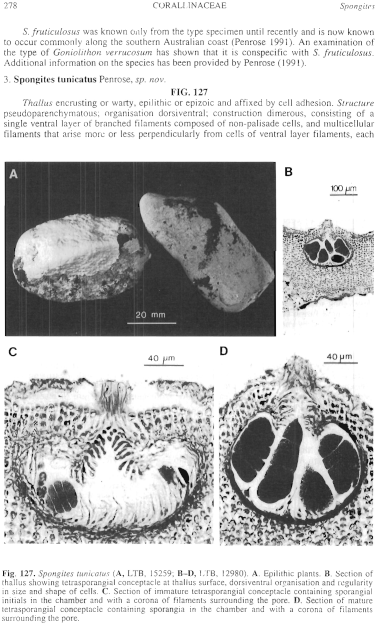|
|
|
|
|
|||||||||||
|
Electronic Flora of South Australia Species Fact Sheet
Phylum Rhodophyta – Class Florideophyceae – Order Corallinales – Family Corallinaceae – Subfamily Mastophoroideae
Thallus encrusting or warty, epilithic or epizoic and affixed by cell adhesion. Structure pseudoparenchymatous; organisation dorsiventral; construction dimerous, consisting of a single ventral layer of branched filaments composed of non-palisade cells, and multicellular filaments that arise more or less perpendicularly from cells of ventral layer filaments, each filament composed of cells 2–9 µm in diameter and 2–11 µm long; single epithallial cells terminating filaments at the thallus surface, distal walls rounded or flattened but not flared; cells of adjacent filaments joined by cell-fusions, secondary pit-connections absent; trichocytes unknown.
Reproduction: Vegetative reproduction, gametangial plants and bisporangia unknown. Tetrasporangia produced in uniporate conceptacles.
Tetrasporangial conceptacle roofs flush with surrounding thallus surface, 3 or 4 cells thick above the chamber, pore canals lined with protruding cells, pores surrounded by coronas of filaments, conceptacle chambers 136–142 µm in diameter and 109–158 µm high; tetrasporangia occurring across chamber floor; each mature sporangium zonately divided.
Type from Variety Bay, Bruny I., Tas. (Woelkerling, Platt & Brown, 17.ii.1983); holotype in LTB (12980), illustrated in Fig. 13B–D and by Penrose (1990, figs 59, 60).
Selected specimens: Crayfish Bay, Otway National Park, Vic., intertidal (Campbell, May & Penrose, 13.xi.1985; LTB, 15262). Blanket Bay, Otway National Park, Vic., intertidal (Campbell, May & Penrose, 13.xi.1985; LTB, 15259). Variety Bay, Bruny I., Tas., 2–4 m deep (Woelkerling, Platt & Brown, 17.ii.1983; LTB, 12980).
Distribution: Known from Otway National Park, Vic., and Bruny I., Tas.
Taxonomic notes: S. tunicatus appears to be most closely related to S. yendoi and is distinguished from this species by the presence of coronas of filaments.
References:
PENROSE, D.L. (1990). Taxonomic studies on Spongites and Neogoniolithon (Corallinaceae, Rhodophyta) in southern Australia. Unpublished PhD Thesis, La Trobe University, Bundoora, Victoria, Australia.
The Marine Benthic Flora of Southern Australia Part IIIB complete list of references.
Publication:
Womersley, H.B.S. (28 June, 1996)
The Marine Benthic Flora of Southern Australia
Rhodophyta. Part IIIB. Gracilarialse, Rhodymeniales, Corallinales and Bonnemaisoniales
Reproduced with permission from The Marine Benthic Flora of Southern Australia Part IIIB 1996, by H.B.S. Womersley. Australian Biological Resources Study, Canberra. Copyright Commonwealth of Australia.
Illustration in Womersley Part IIIA, 1996: FIG. 127.

Figure 127 enlarge
Fig. 127. Spongites tunicatus (A, LTB, 15259; B–D, LTB, 12980). A. Epilithic plants. B. Section of thallus showing tetrasporangial conceptacle at thallus surface, dorsiventral organisation and regularity in size and shape of cells. C. Section of immature tetrasporangial conceptacle containing sporangial initials in the chamber and with a corona of filaments surrounding the pore. D. Section of mature tetrasporangial conceptacle containing sporangia in the chamber and with a corona of filaments surrounding the pore.

|
Email Contact: State Herbarium of South Australia |

|